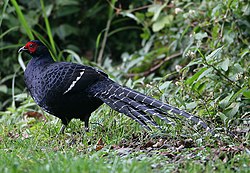| Phasianini | |
|---|---|
 | |
| Green pheasant (Phasianus versicolor) | |
| Scientific classification | |
| Domain: | Eukaryota |
| Kingdom: | Animalia |
| Phylum: | Chordata |
| Class: | Aves |
| Order: | Galliformes |
| Family: | Phasianidae |
| Subfamily: | Phasianinae |
| Tribe: | Phasianini Horsfield, 1821 |
| Genera | |
Syrmaticus | |
Phasianini is a tribe of birds in the subfamily Phasianinae. It contains the true pheasants. Species in this tribe are found throughout Europe and Asia. This grouping was supported by a 2021 phylogenetic analysis of Galliformes, and accepted by the International Ornithological Congress. The tribe name is accepted by the Howard and Moore Complete Checklist of the Birds of the World. [1] [2] [3] [4]





